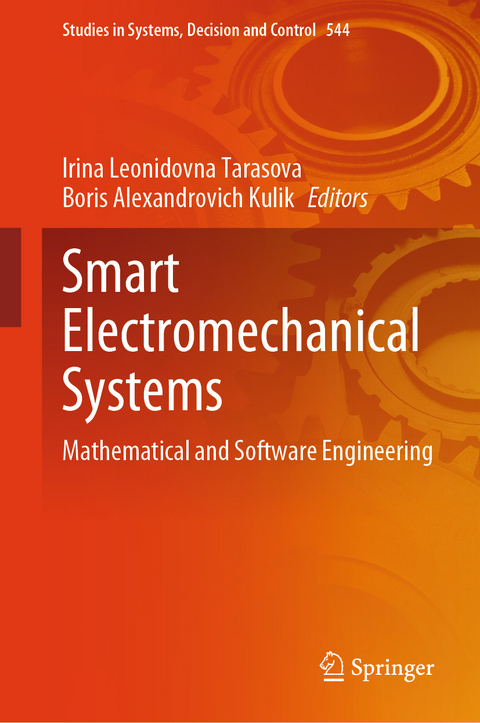
Smart Electromechanical Systems
Springer International Publishing (Verlag)
978-3-031-64276-0 (ISBN)
Irina Leonidovna Tarasova (18.02.1955), Ph.D., Docent, is a senior researcher of the laboratory "Smart electromechanical systems" Institute for Problems in Mechanical Engineering of the Russian Academy of Sciences. Corresponding Member of the Metrological Academy He is the author of 135 scientific papers, 10 monographs and registered more than 10 patents. Research interests include mathematical modeling, artificial intelligence, optimal control, identification and diagnostics.
Boris Alexandrovich Kulik (09.03.1941), Dr. Sc. in Physics and Mathematics, is a leading researcher of the laboratory "Smart electromechanical systems" Institute for Problems in Mechanical Engineering of the Russian Academy of Sciences. Corresponding Member of the Metrological Academy. He is the author of 150 scientific papers, 5 monographs. Research interests include artificial intelligence, logical analysis of data and knowledge.
.- Part 1: SEMS information and measurement systems.
.- 1.1. The accuracy research of the exposed incremental encoder based on image formation method for SEMS applications (Vladimir N. Kuznetsov, Ayur T. Garmaev, Ivan G. Deyneka, Aleksandr S. Vasilev).
.- 1.2. Intelligent support for selecting sensors for information measurement systems (Irina A. Koptelova, Lyudmila A. Konovalova).
.- 1.3. Intelligent information-measuring system for relay protection of overhead power lines with adaptation to external factors (Alexey .A. Shilin, Pavel V. Dikarev, Danila N. Avdeyuk).
.- 1.4. Intelligent information-measuring system for controlling the operating mode of hydroelectric power plants (Alexander N. Shilin, Lyudmila A. Konovalova, Muluken. A. Bogale).
.- Part 2: Formation and Analysis of Databases and Knowledge.
.- 2.1. Creation of databases and formalization of knowledge using identification of SEMS, working under various constrains (Andrey Yu. Kuchmin).
.- 2.2. New methods for recognizing and resolving contradictions in knowledge (Boris A. Kulik, Alexander Ya. Fridman).
.- 2.3. Intellectual model of mobile robots coalitions formation in network-centric group control systems (Vladimir A. Serov, Evgeny M. Voronov, Yulia Yu. Kurilenko).
.- 2.4. Design Ontology for Situational Digital Twins in Modeling Structural Safety within a Group of Intelligent Robots (Alexander Ya. Fridman).
.- Part 3: Recognition and Classification.
.- 3.1. Acoustic energy mapping method for acousto-optical non-destructive testing system with automated positioning (Akhmerov A.Kh., Sycheva S.D., Khodzhimukhamedov O.I., Deyneka I.G., Vasilev A.S., Kulikov A.V.).
.- 3.2. Analysis of the Degree of Differentiation Biological Tissues for Diagnosis of Pathological Processes Using Robotic Spectral Complexes (Ruslan D. Khlynov, Victoria A. Ryzhova, Ekaterina A. Tsygankova, Igor A. Konyakhin, Valery V. Korotaev, Sergey N. Yarishev, Todor S. Djamiykov, Marin B. Marinov).
.- 3.3. Structure of a model of situational control for intelligent robots containing SEMS knowledge bases, by means of coordinating contexts of a specialized language of their communication (Alexander Ya. Fridman, Boris A. Kulik).
.- 3.4. Identification of the SEMS module using the example of a model of a linear electric drive of a counter-reflector actuator taking into account constrains (Andrey Yu. Kuchmin).
.- Part 4: Decision-making.
.- 4.1. Adaptive algorithms for evaluating the effect of microdynamics on crystal growth parameters in the information-control technological module of SEMS in microgravity (Sergey N. Sayapin).
.- 4.2. Model Predictive Control and Genetic Algorithms for Optimization of Continuous Stirred Tank Reactors (Ali Deeb, Vladimir N. Khokhlovskiy, Viacheslav P. Shkodyrev).
.- 4.3. Decision-making when assessing financing risks using the logical and linguistic method. (Andrey E. Gorodetskiy, Irina L. Tarasova, Anna R. Krasavtseva).
.- 4.4. Risk analysis of project financing using the logical-linguistic classification method (Andrey E. Gorodetskiy, Anna R. Krasavtseva, Irina L. Tarasova).
.- Part 5: Formation of control actions.
.- 5.1. Forming an emotional response in a robot (Viacheslav V. Kozlov).
.- 5.2. Autocollimation system with extended distance for angular rotation measurements in SEMS applications (Mikhail M. Nikitin, Igor A. Konyakhin).
.- 5.3. Polarization Imaging of Pathological Biological Tissues Using a Robotic System Based on Multi-Element Sensors (Ruslan D. Khlynov, Victoria A. Ryzhova, Ekaterina A. Tsygankova, Artemii Y. Zhdanov, Igor A. Konyakhin, Valery V. Korotaev, Sergey N. Yarishev, Todor S. Djamiykov, Marin B. Marinov).
.- 5.4. Comparative Analysis of Methods for Classifying Electroencephalography Signals for a Robotic Brain-Computer Interface (Artemii Y. Zhdanov, Victoria A. Ryzhova, Ruslan D. Khlynov, Igor A. Konyakhin, Yuri E. Shelepin).
| Erscheinungsdatum | 21.08.2024 |
|---|---|
| Reihe/Serie | Studies in Systems, Decision and Control |
| Zusatzinfo | IX, 265 p. 77 illus., 51 illus. in color. |
| Verlagsort | Cham |
| Sprache | englisch |
| Maße | 155 x 235 mm |
| Themenwelt | Technik ► Elektrotechnik / Energietechnik |
| Schlagworte | control actions • Cyber-Physical Systems • Decision Making • Electromechanical Systems • SEMS • Smart Systems |
| ISBN-10 | 3-031-64276-7 / 3031642767 |
| ISBN-13 | 978-3-031-64276-0 / 9783031642760 |
| Zustand | Neuware |
| Informationen gemäß Produktsicherheitsverordnung (GPSR) | |
| Haben Sie eine Frage zum Produkt? |
aus dem Bereich


